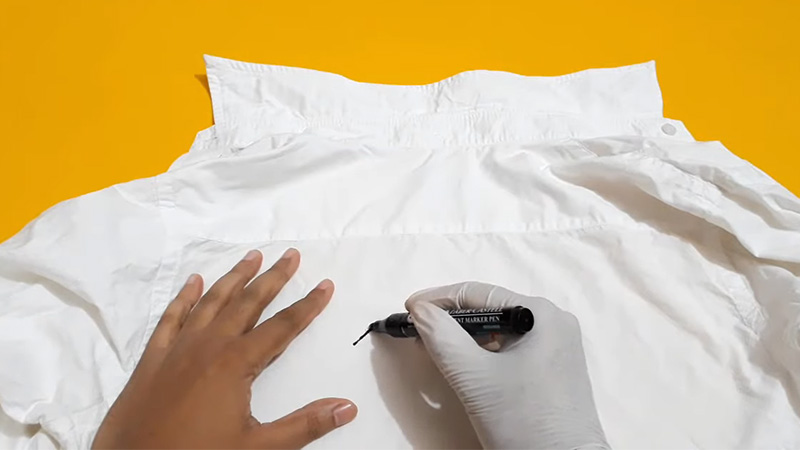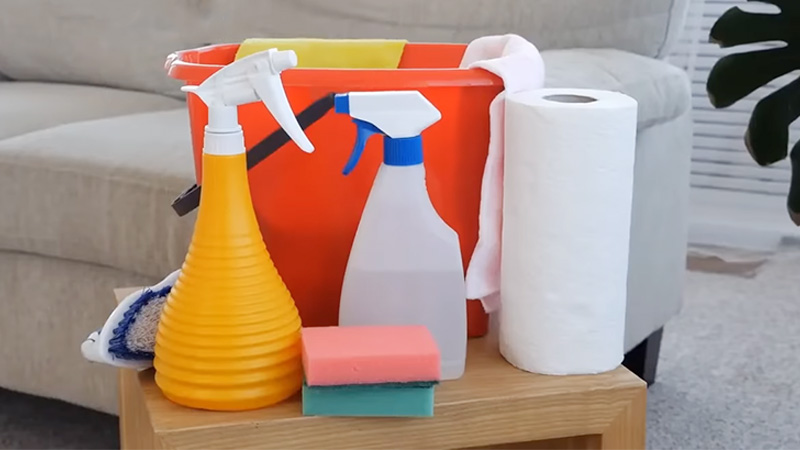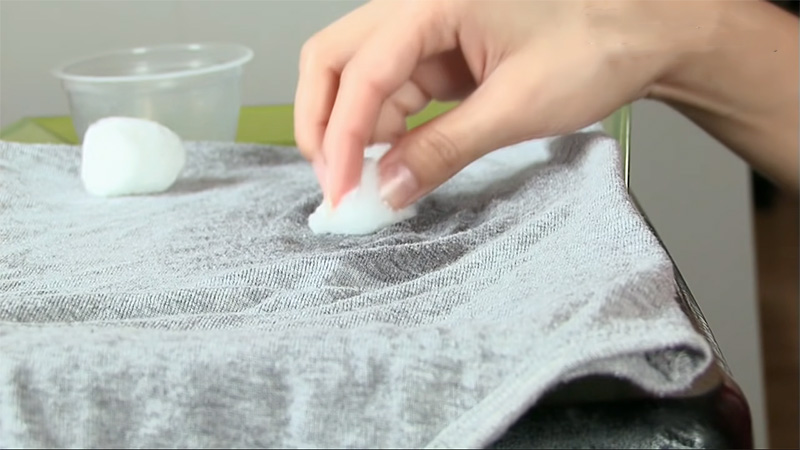Sharpie ink stains on fabric can be a frustrating sight, but with the right techniques, you can successfully remove them and restore your fabric to its former glory.
Whether it’s your favorite shirt, upholstery, or a cherished piece of fabric, knowing how to get Sharpie out of fabric is a valuable skill.
In this comprehensive guide, we will explore how to get Sharpie out of fabric that can help you tackle Sharpie stains on various fabric types. From quick response strategies to natural remedies and specialized products, we’ve got you covered.
By the end of this guide, you’ll be equipped with the knowledge and tools to confidently address Sharpie stains on fabric and keep your textiles looking clean and pristine.

How To Get Sharpie Out Of Fabric?
Removing Sharpie stains from fabric can be challenging, but it’s possible with the right techniques. Here are the simple methods:
Rubbing Alcohol
Apply a small amount of rubbing alcohol to a clean cloth or cotton ball. Gently blot the stained area, starting from the outside and working your way in. Be patient and avoid excessive rubbing, as it can spread the ink. Rinse with water and launder as usual.
Hairspray
Aerosol hairspray can be effective for ink stain removal. Spray a small amount directly onto the stain, then blot with a clean cloth or sponge. Rinse with cold water and launder as usual.
Hand Sanitizer
Alcohol-based hand sanitizers can also help remove Sharpie stains. Apply a small amount to the stain, let it sit for a few minutes, then blot with a clean cloth. Rinse and launder.
Acetone
Acetone, found in nail polish removers, can be used for ink stain removal on some fabrics. Test in an inconspicuous area first to ensure it won’t damage or discolor the fabric. Apply a small amount to the stain, blot, and rinse.
Vinegar and Dish Soap
Mix equal parts of white vinegar and dish soap. Apply the solution to the stain, gently rub, and let it sit for a few minutes. Rinse thoroughly with cold water and launder as usual.
Toothpaste
Non-gel toothpaste can be applied directly to the stain. Gently rub with a soft toothbrush, then rinse with cold water. Repeat as needed and launder.
Milk
Soak the stained fabric in a bowl of milk for a few hours or overnight. Rinse with cold water and launder. Milk can help break down the ink and lift the stain.
Regardless of the method you choose, it’s crucial to act quickly, as fresh ink stains are easier to remove. Always check the care label of your fabric and follow the manufacturer’s recommendations for cleaning.
If the stain persists, consider consulting a professional cleaner, especially for delicate or valuable fabrics.
What Supplies You’ll Need To Clean Sharpie Stains?

Cleaning Sharpie stains from fabric requires specific supplies to effectively tackle the task without damaging the material. Here are the essential supplies you’ll need:
Rubbing Alcohol
Rubbing alcohol is a key ingredient for removing Sharpie stains. It helps break down the ink and lift it from the fabric. Look for isopropyl alcohol with a concentration of at least 70% for best results.
Clean Cloth or Sponge
A clean, white cloth or a soft sponge is essential for blotting and gently rubbing the stain. Avoid using colored or printed cloths, as the ink from the fabric can transfer onto your stained item.
Cotton Balls or Swabs
For precise application of rubbing alcohol or other cleaning solutions, cotton balls or swabs are handy. They allow you to target the stain without spreading it further.
Hairspray (Optional)
Aerosol hairspray can be effective for ink stain removal. It contains alcohol, which can help break down the ink. Choose a non-aerosol, alcohol-based hairspray for the best results.
Acetone (Optional)
Acetone, commonly found in nail polish removers, can be used on some fabrics to remove Sharpie stains. However, it’s essential to test it in an inconspicuous area first to ensure it won’t damage or discolor the fabric.
White Vinegar and Dish Soap (Alternative)
If you prefer a more natural approach, white vinegar and dish soap mixed in equal parts can also be used to remove Sharpie stains. These household items can help break down the ink and lift it from the fabric.
Toothbrush (Soft Bristles)
A toothbrush with soft bristles is helpful for gently scrubbing the stain when using certain cleaning solutions. It allows for precise and controlled application.
Having these supplies on hand allows you to address Sharpie stains promptly and effectively. Remember to follow the care instructions on your fabric and to test any cleaning solution in an inconspicuous area before applying it to the stained area to prevent potential damage or discoloration.
What Natural Home Product Removes Sharpie Ink?

Removing Sharpie ink stains using natural household products can be effective and eco-friendly. Here are the home products, each with a brief description of how they can help:
White Vinegar
White vinegar is a versatile cleaner that can also tackle Sharpie ink stains. Apply a small amount of white vinegar to the stain, blot gently, and rinse with cold water. The acidity of vinegar helps break down the ink.
Baking Soda
Baking soda can be used to create a paste that helps lift Sharpie ink stains. Mix a small amount of baking soda with water to make a paste, apply it to the stain, and gently rub it with a cloth or soft brush. Rinse thoroughly and launder as usual.
Lemon Juice
The natural acidity of lemon juice can help break down ink stains. Apply fresh lemon juice to the stain, let it sit for a few minutes, and then blot with a clean cloth. Rinse with cold water.
Milk
Soaking the stained fabric in a bowl of milk for a few hours or overnight can be effective at removing ink stains. Rinse with cold water and launder as usual after soaking.
Toothpaste (Non-Gel)
Non-gel toothpaste can be used as a gentle abrasive to lift Sharpie ink stains. Apply a small amount of toothpaste to the stain, gently rub with a soft toothbrush, and rinse thoroughly.
Salt and Lemon Juice
Create a paste by mixing salt and lemon juice. Apply the paste to the stain, rub gently, and let it sit for a few minutes before rinsing with cold water.
Cornstarch
Cornstarch can be used to absorb ink from fabric. Cover the stained area with cornstarch, gently press it into the fabric, and let it sit for a few hours or overnight. Brush off the cornstarch, and rinse the fabric with cold water.
When using these natural products to remove Sharpie ink, it’s essential to act quickly and avoid excessive rubbing, which can spread the stain. Always test the method on an inconspicuous area of the fabric first to ensure it won’t cause damage or discoloration.
Additionally, rinse the fabric thoroughly after stain removal to prevent any residue from remaining on the material.
Why Is Removing A Permanent Marker Different From Removing Pen Ink?
Removing permanent marker stains from surfaces can be more challenging than removing pen ink because of several distinct characteristics and properties of permanent markers. Here are the reasons why removing permanent marker is different from removing regular pen ink:
Ink Composition
Permanent markers contain ink formulated with pigments and dyes that are designed to be long-lasting and resistant to fading. Pen ink typically consists of water-based or oil-based ink, which is easier to remove.
Ink Permanence
Permanent marker ink is engineered to adhere firmly to surfaces and resist fading or smudging. It often penetrates porous surfaces more deeply than pen ink, making it harder to lift.
Chemical Composition
Permanent markers often contain a combination of solvents, resins, and binders that help the ink adhere strongly to surfaces. This complex composition makes the ink resistant to many common cleaning agents.
Surface Compatibility
Permanent markers are designed for use on various surfaces, including non-porous ones like plastics, metals, and glass. Pen ink typically works well on porous surfaces like paper but may not bond as strongly to non-porous surfaces.
Time Sensitivity
Permanent marker stains tend to become more ingrained into surfaces the longer they are left untreated. Pen ink stains are often easier to remove, even after some time has passed.
Color Variations
Permanent markers are available in a wide range of colors, including bright and vibrant options. The pigment concentration in these markers can make certain colors, such as red or black, more challenging to remove than lighter pen ink.
Surface Porosity
The porosity of the surface plays a significant role in stain removal. Permanent marker ink can penetrate deeply into porous surfaces like fabric or wood, making it harder to extract compared to pen ink.
Given these factors, it’s important to act quickly when dealing with permanent marker stains and to use appropriate cleaning agents or techniques designed specifically for permanent marker removal on the affected surface.
FAQs
Can Sharpie ink stains be removed from fabric, or are they permanent?
Sharpie ink stains can often be successfully removed from fabric. The key to effective removal is to act quickly and use the appropriate cleaning methods and products for the specific fabric type.
What is the best method for removing Sharpie ink from fabric?
One of the most effective methods is using rubbing alcohol. Apply a small amount of rubbing alcohol to a clean cloth or cotton ball and gently blot the stain, starting from the outside and working your way in.
Avoid excessive rubbing, as it can spread the ink. Rinse with water and launder as usual.
Can natural remedies like lemon juice or vinegar remove Sharpie ink stains from fabric?
Yes, natural remedies like lemon juice and white vinegar can be effective. Lemon juice’s acidity can break down the ink, while white vinegar can help lift the stain. Apply the chosen remedy to the stain, blot or gently rub, and rinse with water.
Does the type of fabric matter when trying to remove Sharpie ink stains?
Yes, the fabric type does matter. Some fabrics are more porous and absorbent, making stain removal easier, while others are less forgiving. It’s essential to consider the fabric type and choose a method that is safe and effective for that particular material.
What should I do if the Sharpie ink stain doesn’t come out after multiple attempts?
If the stain persists after multiple attempts, it’s advisable to consult a professional cleaner, especially for delicate or valuable fabrics. Professional cleaners have specialized tools and expertise to tackle stubborn stains effectively without damaging the fabric.
Conclusion
Getting Sharpie ink out of fabric may seem daunting, but armed with the right techniques, you can effectively erase those unsightly stains. Prompt action is crucial, as fresh stains are easier to remove.
Whether you choose to use rubbing alcohol, hairspray, or natural remedies like vinegar and baking soda, remember to be patient and gentle during the stain-removal process.
Always test any solution in an inconspicuous area before applying it to the stained fabric. Once the stain is gone, rinse the fabric thoroughly and launder it as usual.
With perseverance and the guidance provided in this guide, you can confidently tackle Sharpie stains and ensure your fabrics remain clean and free of ink marks.
Meta:
Leave a Reply